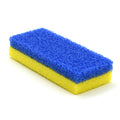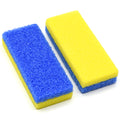How to Fix Pincer Toenails at Home

Pincer toenails can be a literal pain, digging into the toe's delicate skin. A pincer or pinched toenail curves inward instead of rising straight from the nail bed. If you spot any nail curving downward along the sides, you may be developing this common but troublesome problem. But take heart - with diligent home treatment, you can redirect pincer toenail growth to a normal shape.
What Causes Pinched Toenail Curving?
Several factors can lead to toenails curling into a pincer or trumpet shape:
Genetics
Some people inherit a tendency for curved thicker nail growth making them prone to pincering. Look at older relatives' nails to check for a family pattern.
Poor Footwear
Shoes and socks bunching the toes can encourage downward, uneven nail growth. Pressure on nails also adds to the problem. Wear correct toe box shoes.
Injuries
Stubbing the nail, dropping something on your toe, having the nail bend back or experience other traumas can affect nail bed regrowth.
Underlying Conditions
Fungal infections, peripheral circulation issues or metabolic disorders like diabetes can disrupt proper nail formation leading to distortion. See a doctor to diagnose any underlying disease.
Aging
As people age, toenails naturally thicken and lose flexibility, becoming more rigid. They resist pressure rather than bending.
The earlier you start realigning a bending nail with home care, the easier correcting its course will be before curving gets severe. Leaving the problem to worsen makes treatment more difficult.
Read: How to Get Picture-Perfect Blush Nails
Signs You're Developing a Pincer Toenail
Look for these giveaway symptoms of abnormal inward nail curvature:
- Toenail tipping downward at the edges instead of rising straight up
- Rigid thick nail texture instead of being flexible
- Redness, swelling and soreness alongside the nail
- Callus or corn formation alongside the bending edge
- Indentation, groove or flap of skin growing along pincer nail's underside
If you spot a toenail starting to pinch in or curl under, take prompt action to get it growing properly again through home care before problems compound.
Relieving Discomfort from Pincering Nails
As downward-curving nails dig into tender skin, they cause surprisingly intense pain and inflammation requiring relief measures:
Padding
Apply cushioning moleskin, gel pad pieces or cotton under bandages alongside nail to lift pressure. Change padding daily.
Medications
Take over-the-counter pain relievers like NSAID ibuprofen to reduce sensitivity and swelling.
Foot Soaks
Soothe irritated tissue by soaking feet in a basin of cool water mixed with Epsom salts or chamomile tea bags.
Softening Creams
Rub moisturizers like petroleum jelly, glycerin or urea cream on red areas to hydrate and protect.
Open-toed Shoes
Wear footwear allowing maximum air exposure to avoid rubbing at the nail site.
Alleviate discomfort while also treating the underlying nail curvature.
Flattening Techniques for Pincer Toenails
Several methods can relax rigid curving nails to flatten their angle:
Soaking
Soak affected nails 10-15 minutes in warm, soapy water to soften and make temporarily pliable. Finish by sliding floss under nail to lift debris.
Filing
Gently file thick rigid edges with an emery board to round and thin them without cutting corners. Go slowly to avoid stress cracks.
Petroleum Jelly
Soften undersides and edges by applying and massaging in petroleum jelly which permeates to add flexibility. Reapply twice daily.
Urea Cream
Chemically exfoliate and thin nail layers by daily application of a urea cream containing alpha-hydroxy acid to speed growth of smooth new cells.
Glycerin
Hydrate brittle nails using glycerin treatments overnight under cotton gloves to slowly improve texture.
Toenail Adhesives
Apply a thin layer of nail glue (like denture adhesive) on bottom of nails allowing attachment to the nail bed to lift pressure off skin.
With consistent conditioning, thick rigid overgrowth can be coaxed into lying flatter.
How to Trim Pincer Nails
Careful cutting technique keeps painful edges under control:
- Trim protruding corners every few days to avoid allowing them to grow longer and curl more.
- File into corners slightly when trimming to round their shape.
- Never cut nails too short which exposes tender matrix skin underneath.
- Slice main nail body straight across to encourage an upright direction of regrowth.
- Use a large toenail clipper to snip rather than small fingernail trimmers.
Using Protective Devices to Straighten Nails
Specialized orthodontic devices provide tension or padding to realign curling toenail edges:
Toenail Braces
These use a sleeve and adjustable spring mechanism to place lifting pressure against the tip, pulling it off irritated skin. Gentle constant tension retrains the nail to rise straight.
Toenail Caps & Separators
Plastic or gel covers place protective barriers alongside nails while separators push apart digits to remove friction. Wear them even at night.
Splints
Custom splints designed by podiatrists immobilize and cushion nails to heal while also retraining their upright growth.
Wear devices consistently for 8-12 hours daily to mechanically reform nails over several weeks. Monitor for fit.
Also See: How to Do Glazed Donut Nails
When to Seek Medical Treatment
While home care resolves many cases of mild-moderate pincer nails, seek professional help for:
- No improvement after 8-12 weeks of diligent home treatment
- Red skin, discharge or foul odor signalling infection
- Uncontrolled pain and swelling despite padding and medication
- Numerous affected nails causing difficulty walking
- Thick rigid nails resistant to softening by soaks and creams
Doctors can surgically remove problematic nail portions and destroy the matrix with phenol to preclude regrowth. This permanently corrects nail curving when home care fails to relieve severe cases.
Know Your Options to Fix Pincer Toenails
From conditioning treatments to protective devices and possible prescription medicines or surgery, a variety of options exist to realign curving thick rigid nails, relieve associated discomfort, and get your toes back to normal function. Have patience as it takes months for complete new nail growth to eliminate pincer shapes, but it happens a little every day. Pay attention to early warning signs of nails tipping sideways and take prompt at-home action to reverse problems before they require advanced intervention. Through diligent care, most pincer toenails can be corrected non-surgically.Sample Block Quote
Nam tempus turpis at metus scelerisque placerat nulla deumantos sollicitudin delos felis. Pellentesque diam dolor an elementum et lobortis at mollis ut risus. Curabitur semper sagittis mino de condimentum.













